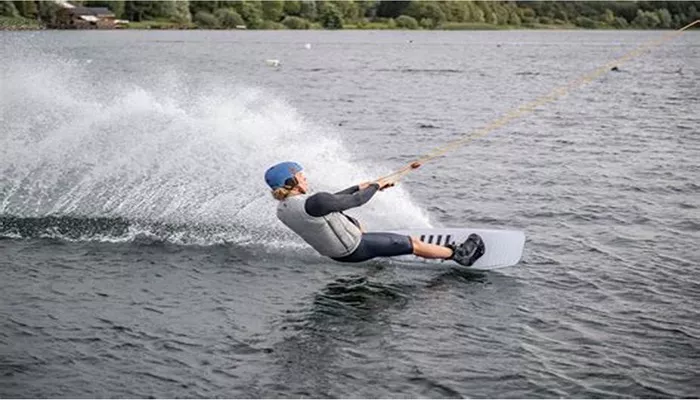Wakeboarding is an exciting water sport that combines elements of surfing, snowboarding, and waterskiing. Typically, a wakeboarder relies on a rope attached to a boat to provide the necessary propulsion. However, the idea of wakeboarding without a rope has sparked curiosity among enthusiasts seeking a new challenge. While it is possible in specific situations, wakeboarding without a rope presents unique challenges and requires specialized conditions. This article explores how it can be done, its practical limitations, and safety considerations.
Understanding The Role of The Rope in Wakeboarding
The rope is a fundamental component in traditional wakeboarding. It connects the rider to the boat and transfers the boat’s kinetic energy to the board, allowing the rider to glide across the water. The rope also provides balance and support, enabling tricks, jumps, and sharp turns.
Without a rope, a wakeboarder must rely on other sources of propulsion and balance, which fundamentally changes the dynamics of the sport.
Is It Possible to Wakeboard Without A Rope?
Yes, it is possible to wakeboard without a rope, but only under specific conditions. The primary method for achieving this is by using the energy of a boat’s wake or a wave, which requires precise alignment and exceptional skill.
Using a Boat’s Wake
Some advanced wakeboarders can ride directly on a boat’s wake without holding onto a rope. This technique, known as wake surfing, involves positioning the wakeboard on the wave created by the boat’s engine. The wake acts like a small, continuous wave, pushing the board forward.
How It Works: The rider starts with a rope to help get into position behind the boat. Once the wakeboard aligns with the boat’s wake, the rider shifts their weight and uses the board’s edges to maintain speed and stability. The rope is then released, and the rider uses the wake’s force to continue moving.
Key Requirements: The boat must have a specialized wakeboarding system or ballast tanks to create a sufficiently large and consistent wake. Riders also need advanced balance and wave-riding skills.
Wakeboarding on Natural Waves
Another way to wakeboard without a rope is by using natural waves in the ocean. This approach closely resembles surfing but requires a wakeboard designed for this purpose.
Challenges: Unlike a boat wake, natural waves are less predictable and harder to maintain alignment with. Riders need to generate and maintain their speed by paddling or timing their entry into the wave perfectly.
Best Locations: Coastal areas with consistent swells, like California or Hawaii, are ideal for this style of wakeboarding.
The Gear You Need for Ropeless Wakeboarding
Wakeboarding without a rope necessitates specific equipment.
Wakeboard
A standard wakeboard can work, but boards designed for wake surfing or ocean waves are better suited. These boards are typically:
Lighter and more buoyant.
Designed with a wider base for stability.
Equipped with fins for better control on waves.
Boat
If you plan to use a boat’s wake, ensure it has:
A wakeboarding tower or ballast system to create a large, consistent wake.
A speed of 10–15 mph to generate the ideal wave size.
Protective Gear
Safety is crucial, so don’t forget:
Life Jacket: A U.S. Coast Guard-approved vest is essential for buoyancy and safety.
Helmet: Protects against head injuries in case of a fall.
Ropeless wakeboarding is not beginner-friendly. It requires mastery of the following skills:
Balance and Weight Distribution
Staying balanced without the support of a rope is one of the biggest challenges. Riders must constantly shift their weight to maintain stability and control.
Wave Reading
Understanding how waves form and move is essential. Riders need to position themselves correctly to harness the wave’s energy.
Edge Control
Skillful use of the wakeboard’s edges allows riders to maintain speed and direction while navigating waves.
Advantages of Ropeless Wakeboarding
Wakeboarding without a rope offers several unique benefits:
Increased Freedom: Without a rope, riders experience a sense of freedom and connection with the water.
Skill Development: It challenges wakeboarders to improve balance, control, and wave-reading skills.
Environmentally Friendly: Wakeboarding on natural waves eliminates the need for a boat, reducing fuel consumption and environmental impact.
Limitations of Wakeboarding Without A Rope
Despite its appeal, ropeless wakeboarding has significant limitations:
Skill Barrier: It’s not suitable for beginners or even intermediate riders.
Dependence on Conditions: Success depends on specific conditions like the size and consistency of the wake or waves.
Limited Trick Potential: Performing advanced tricks is harder without the pull and support of a rope.
Safety Considerations
Ropeless wakeboarding introduces additional risks. Here are some key safety tips:
Stay Aware of Surroundings
In open water, always be aware of other boats, swimmers, and potential hazards like rocks or shallow areas.
Use a Spotter
If wakeboarding behind a boat, have a spotter to monitor your position and ensure your safety.
Learn the Basics First
Before attempting ropeless wakeboarding, master traditional wakeboarding with a rope to build the necessary skills and confidence.
Can Beginners Try Wakeboarding Without a Rope?
While it’s not recommended for beginners, they can start working toward this goal with structured training:
Practice with a Rope First: Build strength, balance, and edge control while holding a rope.
Learn to Wakesurf: Transition to using the boat’s wake for propulsion while still holding the rope.
Gradually Release the Rope: Once you feel stable on the wake, practice releasing the rope for short periods.
Conclution
Wakeboarding without a rope is a thrilling and challenging variation of the sport. While it’s achievable for experienced riders, the technical demands and reliance on perfect conditions make it less accessible than traditional wakeboarding. For those looking to push their skills and experience wakeboarding in a new way, it’s an exciting goal to strive for.
Related topics:
- When Did Wakeboarding Become Popular?
- How Fast Should You Wakeboard?
- How to Start Wakeboarding: A Step-by-Step Guide

